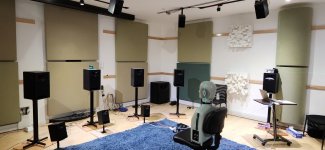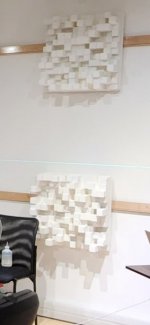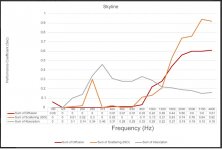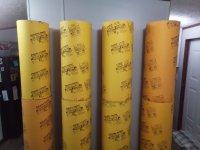Sean Olive from Harman posted an interesting paper on room diffusers:
https://zelfbouwaudio.nl/forum/download/file.php?id=156692
The paper is a bit dry, but the conclusion is basically that you can diffuse sound very effectively using a cylinder that's split in half and mounted to the walls of the listening room.
I thought this was particularly interesting, because cylindrical subs perform really well and they're very inexpensive to build.
I'm not sure what construction places are near you, but where I am, "White Cap" offers Sonotubes in diameters up to about 36-48" in diameter.
I've also found in my speaker experiments that it's possible to take smaller sonotubes and bend them into larger shapes.
For instance: the circumference of a 12" sonotube is 37.69". The circumference of a 24" sonotube is 75.4". So you can take a 12" diameter Sonotube, cut it in half, bend it, and get a hemispherical sonotube that's 24" in diameter.
Which is handy if the only places you have access to are Home Depot or Lowes, which only carry Sonotubes up to a diameter of twelve inches.
https://zelfbouwaudio.nl/forum/download/file.php?id=156692
The paper is a bit dry, but the conclusion is basically that you can diffuse sound very effectively using a cylinder that's split in half and mounted to the walls of the listening room.
I thought this was particularly interesting, because cylindrical subs perform really well and they're very inexpensive to build.
I'm not sure what construction places are near you, but where I am, "White Cap" offers Sonotubes in diameters up to about 36-48" in diameter.
I've also found in my speaker experiments that it's possible to take smaller sonotubes and bend them into larger shapes.
For instance: the circumference of a 12" sonotube is 37.69". The circumference of a 24" sonotube is 75.4". So you can take a 12" diameter Sonotube, cut it in half, bend it, and get a hemispherical sonotube that's 24" in diameter.
Which is handy if the only places you have access to are Home Depot or Lowes, which only carry Sonotubes up to a diameter of twelve inches.
Attachments
I haven't read the paper yet but you need to understand what a poly cylindrical diffuser does...and its limits : it produces spatial dispersion, but no temporal dispersion. A "real" diffuser does both.

The single semi- cylinder produces excellent spatial dispersion, but as can be seen from Figure 1, there is no temporal dispersion. Consequently, the frequency response of the combined incident and reflected sound shows a comb filtered response due to the similarity between the two sounds. This might be why the sound from semi-cylinders has been disliked. The only study to look at this scientifically was a small scale study by Lee10, who came to the conclusion that reflections from modulated surfaces are preferred to those from simple curved surfaces.
Consequently, a good diffuser needs to generate spatial AND temporal dispersion.
While a Schroeder diffuser may be designed purely for its spatial scattering properties, it naturally generates temporal dispersion because of its complex geometry (provided the period width is wide enough). In the case of semi- cylinders, arranging them in a periodic array may not be sufficient to disperse the temporal response, and some form of randomised arrangement is probably needed.
Another critical application for highlighting the differences between spatial and temporal dispersion is stage shells. The side and rear walls of stages are sometimes flat, and sometimes have diffusing surfaces. While there is evidence that diffusing stage shells are useful11, many practitioners still favour flat surfaces."
ACOUSTIC DIFFUSERS: THE GOOD, THE BAD AND THE UGLY
T J Cox, Salford University
The single semi- cylinder produces excellent spatial dispersion, but as can be seen from Figure 1, there is no temporal dispersion. Consequently, the frequency response of the combined incident and reflected sound shows a comb filtered response due to the similarity between the two sounds. This might be why the sound from semi-cylinders has been disliked. The only study to look at this scientifically was a small scale study by Lee10, who came to the conclusion that reflections from modulated surfaces are preferred to those from simple curved surfaces.
Consequently, a good diffuser needs to generate spatial AND temporal dispersion.
While a Schroeder diffuser may be designed purely for its spatial scattering properties, it naturally generates temporal dispersion because of its complex geometry (provided the period width is wide enough). In the case of semi- cylinders, arranging them in a periodic array may not be sufficient to disperse the temporal response, and some form of randomised arrangement is probably needed.
Another critical application for highlighting the differences between spatial and temporal dispersion is stage shells. The side and rear walls of stages are sometimes flat, and sometimes have diffusing surfaces. While there is evidence that diffusing stage shells are useful11, many practitioners still favour flat surfaces."
ACOUSTIC DIFFUSERS: THE GOOD, THE BAD AND THE UGLY
T J Cox, Salford University
I use 12" ones behind my listening space, works well, minimal cost, hand width apart.
Last edited:
While a Schroeder diffuser may be designed purely for its spatial scattering properties, it naturally generates temporal dispersion because of its complex geometry (provided the period width is wide enough). In the case of semi- cylinders, arranging them in a periodic array may not be sufficient to disperse the temporal response, and some form of randomised arrangement is probably needed.
Another critical application for highlighting the differences between spatial and temporal dispersion is stage shells. The side and rear walls of stages are sometimes flat, and sometimes have diffusing surfaces. While there is evidence that diffusing stage shells are useful11, many practitioners still favour flat surfaces."[/I]
ACOUSTIC DIFFUSERS: THE GOOD, THE BAD AND THE UGLY
T J Cox, Salford University
When looking at the Harman diffusers, something that occurred to me is that you may be able to combine diffusion and absorption.
Basically, you use a hemispherical diffuser, but add a series of holes or slots in the diffuser. Then fill the diffuser with something like rockwool. This would have the effect of absorbing a fraction of the energy that hits the diffuser. It would basically be both a diffuser AND an absorber.
I wouldn't call it diffusers since they do not provide temporal diffusion. They only redirect signal in a specular way.
As long as you are aware of this, it's cool, and you can use them (mainly) as absorber. 🙂
As long as you are aware of this, it's cool, and you can use them (mainly) as absorber. 🙂
Yes, certainly. You would then have an amplitude diffuser rather than a "poly" diffuser. I suspect much better and certainly "diy-able."
When looking at the Harman diffusers, something that occurred to me is that you may be able to combine diffusion and absorption.
Basically, you use a hemispherical diffuser, but add a series of holes or slots in the diffuser. Then fill the diffuser with something like rockwool. This would have the effect of absorbing a fraction of the energy that hits the diffuser. It would basically be both a diffuser AND an absorber.
Attachments
Sounds like you're basically describing the modern TubeTrap. They have quarter and half versions also, but the picture for the full cylinder better shows what's going on.something that occurred to me is that you may be able to combine diffusion and absorption.
Basically, you use a hemispherical diffuser, but add a series of holes or slots in the diffuser. Then fill the diffuser with something like rockwool. This would have the effect of absorbing a fraction of the energy that hits the diffuser. It would basically be both a diffuser AND an absorber.
https://www.acousticsciences.com/product/tubetrap-isothermal/
That placement of a reflective half cylinder isn't making sense for me. It appears to be in line with the listening position. If so any first wall reflection from that point without it would reflect behind the listener. The left side of a reflective (?) cylinder presents angles that would direct more first reflection toward the listener.When looking at the Harman diffusers
Is it an absorber?
Similar concept for combining absorption and diffusion can be done with slatted panels and absorption behind the slats. The smaller the gap size between the slats will lower the absorption frequency, but still provide diffusion in the higher frequencies.

Another article demonstrates how to use a "Pseudo Random Noise Sequence" for the slats to achieve both amplitude and phase grating:
"Pseudo Random Noise Sequence, one generator realization is shown in Figure 1, is a binary sequence. The sequence basically can be as long we need. A diffuser built using this sequence can be amplitude grating only. But if we use more than just one element of the long binary sequence to “program” slat height, we can introduce a phase grating effect this way. So, using two, three or four adjacent numbers of the binary sequence, can define four, eight or sixteen different numbers, which can be used for slat height definition. This way we define quaternary, octal or hexadecimal diffuser, instead of just binary, by using the same PRN sequence. This construction will work as a phase grating diffuser."
Another article demonstrates how to use a "Pseudo Random Noise Sequence" for the slats to achieve both amplitude and phase grating:
"Pseudo Random Noise Sequence, one generator realization is shown in Figure 1, is a binary sequence. The sequence basically can be as long we need. A diffuser built using this sequence can be amplitude grating only. But if we use more than just one element of the long binary sequence to “program” slat height, we can introduce a phase grating effect this way. So, using two, three or four adjacent numbers of the binary sequence, can define four, eight or sixteen different numbers, which can be used for slat height definition. This way we define quaternary, octal or hexadecimal diffuser, instead of just binary, by using the same PRN sequence. This construction will work as a phase grating diffuser."
Attachments
@tom1066, you are reading much the same as me as I prepare to comprehensively treat my room. Both of your attachments are in the "research" folder on my desktop. 🙂
I plan to totally rebuild the wall behind my speakers (I sit too close to the back wall to use diffusion, I think), and am trying to decide between:
Looking at Patrick's room, I am actually fairly confident that it could sound absolutely fantastic with good acoustical treatment. Most acousticians when building from-scratch monitoring rooms in studios specify 13' minimum. I would love to have that high ceiling.
Bill
I plan to totally rebuild the wall behind my speakers (I sit too close to the back wall to use diffusion, I think), and am trying to decide between:
- an air transparent diffuser as outlined by "Boggy" in the paper you attached,
- a one-dimensional slatted panel absorber
- a 2D binary amplitude diffuser/absorber
- a simple slatted absorber not designed to diffuse (slat width only reflective at very high frequencies)
- perforated metal walls with > 35% or so open area. Again, just an absorber.
Looking at Patrick's room, I am actually fairly confident that it could sound absolutely fantastic with good acoustical treatment. Most acousticians when building from-scratch monitoring rooms in studios specify 13' minimum. I would love to have that high ceiling.
Bill
Last edited:
See below..............
https://everythingacoustic.co.uk/products/skyline-6
4.6" deep (120mm)
Far too costly...............
it works past 3khz anyway
Well, 1129 ft per sec / (4.6" / 12") = 3khz
Hmm, numbers match, imagine that.
I would try for at least 12" deep to get down closer to 1khz................
I like a "live" room but no echos, hence I fall into the sonotube diffuser realm.
I've had 6" thick foam all over the place, room was too "dead" for my likes.
https://everythingacoustic.co.uk/products/skyline-6
4.6" deep (120mm)
Far too costly...............
it works past 3khz anyway
Well, 1129 ft per sec / (4.6" / 12") = 3khz
Hmm, numbers match, imagine that.
I would try for at least 12" deep to get down closer to 1khz................
I like a "live" room but no echos, hence I fall into the sonotube diffuser realm.
I've had 6" thick foam all over the place, room was too "dead" for my likes.
Attachments
Last edited:
Hearing someone speaking at a cylinder, I like what I hear.
Hearing someone speak at a quadratic, it sounds like a mess.
Talking at a poly, sure it sounds pinched with the mike where the 2 curves pinch together, but sounds great anywhere else along the curved surface. Not my fault he took 6 hours to make that thing.
talking at 8:50-8:57 at the poly.
listening to the poly diffuser with guitar at 9:50 vs the qrd diffuser at 10:45, the qrd adds a lot of chaos to my ears compared to the simple poly, sounds like added reverb, more live = bad, like added extra reflections (echos) in horns with stepped paths like ev diffraction horns, hp 640, hp940, and even the hr90 I had.
He clearly prefers the qrd...............
Hearing someone speak at a quadratic, it sounds like a mess.
Talking at a poly, sure it sounds pinched with the mike where the 2 curves pinch together, but sounds great anywhere else along the curved surface. Not my fault he took 6 hours to make that thing.
talking at 8:50-8:57 at the poly.
listening to the poly diffuser with guitar at 9:50 vs the qrd diffuser at 10:45, the qrd adds a lot of chaos to my ears compared to the simple poly, sounds like added reverb, more live = bad, like added extra reflections (echos) in horns with stepped paths like ev diffraction horns, hp 640, hp940, and even the hr90 I had.
He clearly prefers the qrd...............
...
Basically, you use a hemispherical diffuser, but add a series of holes or slots in the diffuser. Then fill the diffuser with something like rockwool. This would have the effect of absorbing a fraction of the energy that hits the diffuser. It would basically be both a diffuser AND an absorber.
Something like the RPG BAD ARCs, GIK's PolyFusor and their DIY clones ?
Last edited:
I recognize my basement floor and the back of my recliner sofa 😎 . And remember how utterly boring and tedious it was to drill all those holes ... If I where to start from scratch with my listening / HT room or wanted to upgrade it and was considering an effective and true diffuser which is also easy to build, it would be a volume diffuser. I posted some info on volume diffusers here: https://www.diyaudio.com/community/...grated-with-bass-absorber.389034/post-7090634 There is a link to an excel spread sheet in post #2 if one wants to customize its width and depth to suit ones own room. In the thesis from Hughes on volume differs you can find comparisons versus other types of diffusers which can be purchased or built..
If one doesn't have MS excel, the spread sheet can also be opened with other free downloadable programs. A volume diffuser needs to be quite deep and wide to work properly from midrange and upwards but that would be the case also for other diffusers. 10 cm / 4 inches deep and size say 60x60 cm / 2'x2' will not do much except at "higher frequencies".
If one doesn't have MS excel, the spread sheet can also be opened with other free downloadable programs. A volume diffuser needs to be quite deep and wide to work properly from midrange and upwards but that would be the case also for other diffusers. 10 cm / 4 inches deep and size say 60x60 cm / 2'x2' will not do much except at "higher frequencies".
Last edited:
- Home
- Loudspeakers
- Multi-Way
- Cheap / Effective Diffusors



